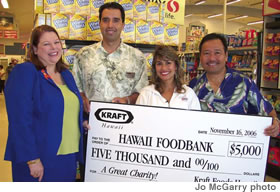Shopping For The Homeless

Wednesday - November 22, 2006
| Share
 Del.icio.us
Del.icio.us
(from left) Polly Kauahi, director of development, Hawaii
Foodbank, George Glukfeld, GM Safeway Hawaii,
Sweetie Pacarro, spokesperson for Kraft Foods Hawaii
and Gerald Shintaku, customer business manager for
Kraft Foods Hawaii
Each week, as I write about food and wine, there are a number of stock phrases I frequently use.
“Food-friendly” - wines that match well with certain foods.
“Food-pairing” - chef and winemaker collaborations.
“Foodie” -someone enthusiastic about cooking and eating.
But I’m using one this week for the first time and it shocks me by its very existence: “Food insecure” - a person hungry and in danger of going without a meal.
It’s a term that’s used by the government to describe the hundreds of thousands of people in America who have literally no idea where their next meal is coming from. And in Hawaii, those thousands of hungry people include almost 33,000 children.
“This year, the problems of the hungry have been exacerbated by high rents and displacements,” says Dick Grimm, president of the Hawaii Foodbank. “Where in the past we had high numbers of hungry children, they at least had a home to go to. Today there are many more children who are hungry and homeless too.”
If you’re a mother, a father, a grandparent, an auntie or anyone connected to a child in some way, just take a moment to imagine the reality of that statement, that many of Hawaii’s hungry children are homeless, too. I can’t make a trip to Safeway during the holidays without counting my blessings. As I fill up our shopping cart with much the same items you do, I find myself imagining the agony of not being able to feed my children.
That’s why Kraft’s Check Out Hunger is one of my favorite campaigns of the year. Those little green tickets you’ll see at each checkout in Safeway, Times and Tamura’s are a reminder that Hawaii’s hungry need our help, as well as a reminder that we can affect change every time we shop.
“I think that people in Hawaii are extremely giving,” says Grimm, “and the purpose of the green coupon is to really drive home the facts of hunger, right there at the checkout.”
The Kraft program is one of the most successful fundraisers of the year for the Foodbank. Last year it raised more than $98,000 - money that is used solely to purchase food. Here’s how it works: Pick up a coupon at the checkout and add it to your own grocery bill. You can keep the coupon and use it each time you shop.
“I think that having the coupons right there as people are thinking about food makes it more of a simpler choice,” says Grimm. “It’s easier to say let’s share when you’re buying food for your own family.”
It costs $2.81 to feed a child breakfast for a week, $12.43 to feed a senior lunch for a month and $16.84 to feed a family dinner for a week.
Donations at the Foodbank are down this year, and for charities in Hawaii in general it’s becoming more of a challenge to raise funds. But I have a feeling that this year’s Kraft campaign will be one of the most successful ever, because I believe that, like me, you’re so thankful and aware of the blessings in your lives. Donating couldn’t be easier - just add the coupon as an item on your grocery list. You know the kind of thing - cranberries, turkey, bread, a meal for a hungry child for a week, Cheerios.
Still having second thoughts as you pull out your wallet? Just take a moment to look around the store. Smell the freshly baking bread and the aroma of roasting chickens, think about dinner with your family and the incredible feeling of sharing food with people you love.
And then imagine turning to your child with nothing to give them to eat.
Happy Thanksgiving.
E-mail this story | Print this page | Comments (0) | Archive | RSS Comments (0) |
Most Recent Comment(s):












